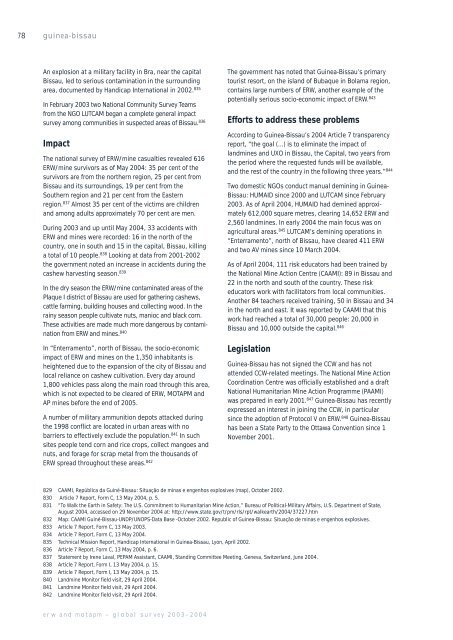Country & Territory Reports - Landmine Action
Country & Territory Reports - Landmine Action
Country & Territory Reports - Landmine Action
You also want an ePaper? Increase the reach of your titles
YUMPU automatically turns print PDFs into web optimized ePapers that Google loves.
78 guinea-bissau<br />
An explosion at a military facility in Bra, near the capital<br />
Bissau, led to serious contamination in the surrounding<br />
area, documented by Handicap International in 2002. 835<br />
In February 2003 two National Community Survey Teams<br />
from the NGO LUTCAM began a complete general impact<br />
survey among communities in suspected areas of Bissau. 836<br />
Impact<br />
The national survey of ERW/mine casualties revealed 616<br />
ERW/mine survivors as of May 2004: 35 per cent of the<br />
survivors are from the northern region, 25 per cent from<br />
Bissau and its surroundings, 19 per cent from the<br />
Southern region and 21 per cent from the Eastern<br />
region. 837 Almost 35 per cent of the victims are children<br />
and among adults approximately 70 per cent are men.<br />
During 2003 and up until May 2004, 33 accidents with<br />
ERW and mines were recorded: 16 in the north of the<br />
country, one in south and 15 in the capital, Bissau, killing<br />
a total of 10 people. 838 Looking at data from 2001-2002<br />
the government noted an increase in accidents during the<br />
cashew harvesting season. 839<br />
In the dry season the ERW/mine contaminated areas of the<br />
Plaque I district of Bissau are used for gathering cashews,<br />
cattle farming, building houses and collecting wood. In the<br />
rainy season people cultivate nuts, manioc and black corn.<br />
These activities are made much more dangerous by contamination<br />
from ERW and mines. 840<br />
In “Enterramento”, north of Bissau, the socio-economic<br />
impact of ERW and mines on the 1,350 inhabitants is<br />
heightened due to the expansion of the city of Bissau and<br />
local reliance on cashew cultivation. Every day around<br />
1,800 vehicles pass along the main road through this area,<br />
which is not expected to be cleared of ERW, MOTAPM and<br />
AP mines before the end of 2005.<br />
A number of military ammunition depots attacked during<br />
the 1998 conflict are located in urban areas with no<br />
barriers to effectively exclude the population. 841 In such<br />
sites people tend corn and rice crops, collect mangoes and<br />
nuts, and forage for scrap metal from the thousands of<br />
ERW spread throughout these areas. 842<br />
829 CAAMI, República da Guiné-Bissau: Situação de minas e engenhos explosives (map), October 2002.<br />
830 Article 7 Report, Form C, 13 May 2004, p. 5.<br />
831 “To Walk the Earth in Safety: The U.S. Commitment to Humanitarian Mine <strong>Action</strong>,” Bureau of Political-Military Affairs, U.S. Department of State,<br />
August 2004, accessed on 29 November 2004 at: http://www.state.gov/t/pm/rls/rpt/walkearth/2004/37227.htm<br />
832 Map: CAAMI Guiné-Bissau-UNDP/UNOPS-Data Base -October 2002. Republic of Guinea-Bissau: Situação de minas e engenhos explosives.<br />
833 Article 7 Report, Form C, 13 May 2003.<br />
834 Article 7 Report, Form C, 13 May 2004.<br />
835 Technical Mission Report, Handicap International in Guinea-Bissau, Lyon, April 2002.<br />
836 Article 7 Report, Form C, 13 May 2004, p. 6.<br />
837 Statement by Irene Laval, PEPAM Assistant, CAAMI, Standing Committee Meeting, Geneva, Switzerland, June 2004.<br />
838 Article 7 Report, Form I, 13 May 2004, p. 15.<br />
839 Article 7 Report, Form I, 13 May 2004, p. 15.<br />
840 <strong>Landmine</strong> Monitor field visit, 29 April 2004.<br />
841 <strong>Landmine</strong> Monitor field visit, 29 April 2004.<br />
842 <strong>Landmine</strong> Monitor field visit, 29 April 2004.<br />
erw and motapm – global survey 2003–2004<br />
The government has noted that Guinea-Bissau’s primary<br />
tourist resort, on the island of Bubaque in Bolama region,<br />
contains large numbers of ERW, another example of the<br />
potentially serious socio-economic impact of ERW. 843<br />
Efforts to address these problems<br />
According to Guinea-Bissau’s 2004 Article 7 transparency<br />
report, “the goal (...) is to eliminate the impact of<br />
landmines and UXO in Bissau, the Capital, two years from<br />
the period where the requested funds will be available,<br />
and the rest of the country in the following three years.” 844<br />
Two domestic NGOs conduct manual demining in Guinea-<br />
Bissau: HUMAID since 2000 and LUTCAM since February<br />
2003. As of April 2004, HUMAID had demined approximately<br />
612,000 square metres, clearing 14,652 ERW and<br />
2,560 landmines. In early 2004 the main focus was on<br />
agricultural areas. 845 LUTCAM’s demining operations in<br />
“Enterramento”, north of Bissau, have cleared 411 ERW<br />
and two AV mines since 10 March 2004.<br />
As of April 2004, 111 risk educators had been trained by<br />
the National Mine <strong>Action</strong> Centre (CAAMI): 89 in Bissau and<br />
22 in the north and south of the country. These risk<br />
educators work with facilitators from local communities.<br />
Another 84 teachers received training, 50 in Bissau and 34<br />
in the north and east. It was reported by CAAMI that this<br />
work had reached a total of 30,000 people: 20,000 in<br />
Bissau and 10,000 outside the capital. 846<br />
Legislation<br />
Guinea-Bissau has not signed the CCW and has not<br />
attended CCW-related meetings. The National Mine <strong>Action</strong><br />
Coordination Centre was officially established and a draft<br />
National Humanitarian Mine <strong>Action</strong> Programme (PAAMI)<br />
was prepared in early 2001. 847 Guinea-Bissau has recently<br />
expressed an interest in joining the CCW, in particular<br />
since the adoption of Protocol V on ERW. 848 Guinea-Bissau<br />
has been a State Party to the Ottawa Convention since 1<br />
November 2001.


